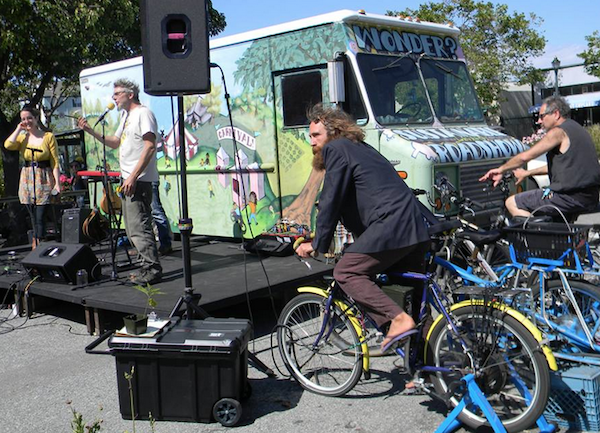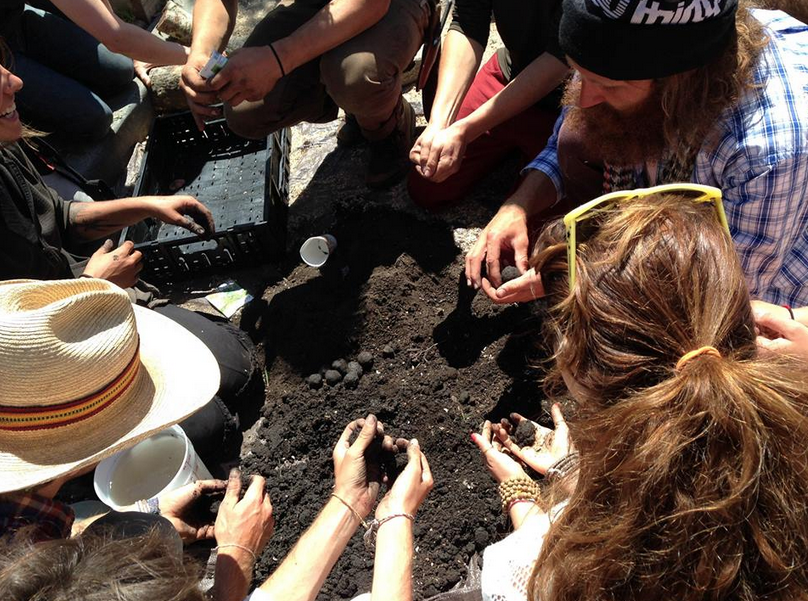Oakland, California is in the midst of an impressive month-long ShareFest featuring swaps, gift circles, workshops and more. One of the highpoints so far was the Creating Commons Festival that took place on May 10th. Organized by Jonathan Youtt and Veronica Ramirez, and funded in part by a grant from Shareable for our #SharingSpring initiative, the event was held at the PLACE for Sustainable Living. It brought together an estimated 400 people for making, sharing, learning, music, cycling and more.
Among the many events and activities presented were skillshares, neighborhood garden installations, clothing, plant swaps, and public placemaking projects that “reimagine and re-energize the creation of the commons throughout the neighborhood.”

Mushroom inoculation was a highpoint of the festival. Photo: Villagecraft.
Inspired by City Repair's Village Building Convergence, Sunday Streets, Oakland's Art Murmur and the mini-Maker Faires, organizers collaborated with a number of organizations and projects including the East Bay ShareFest, the Community Resilience Challenge, PLACE for Sustainable Living, Villagecraft, Planting Justice, Whymcyles, Phat Beets Produce, SPAGGIA (a neighborhood association), St. Columba Catholic Church, Conscious Carnival, PuppetPLEX Presents, Shake Your Peace, Rock the Bike, Spokeland, Urban Permaculture Institute, Gill Tract Farm Coalition, Oakland Roots, Cornerstone Farms, KALA Institute Artists in Residence Program and a class from the UC Berkeley Planning Dept.
Creating Commons featured a solar and bicycle powered stage, several natural building and permaculture projects, workshops in a variety of subjects, ranging from urban gardening, bicycle maintenance and electric bicycle modification, community resiliency, preparedness training, fermentation, mushroom inoculation, evaporation cooling (refrigeration without electricity) and creating parklets with benches, tables and planters.

Workshops, information tables and crafts were all part of the festival. Photo: Veronica Ramirez
There was also a clothing, plant and seed swap; a 100 person community ceremony that was opened by a local Aztec dance group and followed by words of peace offered by several faith leaders from neighboring churches and other spiritual practices, as well as local poets, artists, neighbors and elders; a Kidzone with Conscious Carnival, an environmentally-themed carnival, games and a youth art creation station, “funky bikes” to ride and an obstacle course; neighborhood presentations from UC Berkeley Planning Dept Students about their local mapping project of our neighborhood, as well as the KALA Institute Artists in Residence Program; several nonprofits tabling; local arts and crafts; and a free barbeque hosted by the neighboring St. Columba Church.
According to organizers, the mushroom inoculation was a highlight that ran most of the day with folks drilling holes, and inserting wood plugs that were previously inoculated with oyster and shiitake mushroom spores. Close to 100 logs were inoculated and taken home by neighbors to wait for the fruiting mushrooms to offer up in the future.

A solar- and bicycle-powered stage kept participants busy. Photo: Veronica Ramirez
ShareFest organizers worked with several organizations over three months to coordinate the festival, which was entirely volunteer driven. They initially held weekly meetings with homework assignments for each group, and then moved to 2-3 meetings per week in the final month. The biggest challenge for them was not having enough core organizers throughout the early stages of production and doing this on a volunteer basis. It became up to a 3/4 time job for the two main organizers for the last three weeks of the festival and prevented them from earning wages elsewhere.
The main expense was liability insurance of $250, followed by street closure and amplified sound permits from the city of Oakland, and printed materials. A $500 grant from Shareable covered a significant amount of these expenses. All the talent, instructors and organizers worked for free and the stage and sound system were also donated.

Who doesn't love a "funky bike?" Photo: Villagecraft
For those planning similar projects, the organizers advise collaborating with as many organizations as you can that can bottom-line certain aspects of the desired activities. “The more decentralized your production, the better, and the less that rests on the main organizers,” says Youtt.

A local Aztec dance group kicked off the day. Photo: Villagecraft
Looking forward, organizers have big plans including monthly sharefests and skillshares, moving to different neighborhoods, and eventually doing green makeovers of existing park and community centers. As Youtt says:
“We ultimately would like to use this model to encourage replication and move from neighborhood to neighborhood helping to mobilize people to create a similar block party with a purpose, resulting in the re-imagination and community co-creation of the commons throughout our region. Additionally we help to bring neighbors out to meet one another, discuss their neighborhood needs, concerns and visions, and learn practical skills in urban sustainability and preparedness including gardening, rainwater and greywater installation, entertainment, barter & sharing exchanges including clothing exchange, crop and seed swap and plant giveaways all within a positive family friendly environment.”

Resilience training in action. Photo: Villagecraft
He offers the following as potential organizations to partner with: resident associations, schools, nonprofits and community based organizations, local merchants, faith based organizations, neighborhood emergency response teams, block captains, relevant city departments, local trade associations that would participate in the trainings especially in their related field (rainwater and greywater workshops for plumbers, solar and wind renewable energy classes for electricians, natural building alternatives for carpenters). He also encourages booths to explore the formation of neighborhood bulk food buying coops, CSA drop sites, a barter exchange, neighborhood resource mapping and community preparedness training.

Winding things down with a jam. Photo: Veronica Ramirez
In the end, the festival was a great success and left people wanting more. “Given the opportunity,” says Youtt, “people tend to want to share. When people give, the natural response is to give back. People loved the event and continuously asked when the next one was planned.”
To see if your city is planning a ShareFest and find resources to help you organize one, check out our article, What Are You Waiting For? Join the #SharingSpring!
##
Top photo: Veronica Ramirez. Follow @CatJohnson on Twitter









